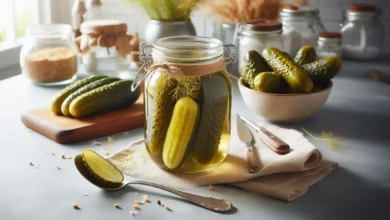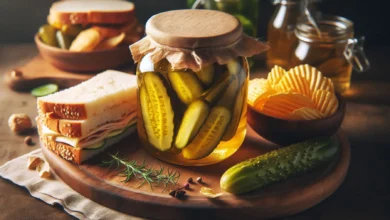Homemade Dill Pickle Recipe: A Classic and Tangy Delight
How to Make Delicious and Healthy Dill Pickles at Home

Introduction
Dill pickles are a classic, crunchy snack that is easy to make at home. This homemade dill pickle recipe offers a simple way to enjoy the tangy flavor of pickles with all the benefits of fresh ingredients. Whether you’re new to pickling or a seasoned pro, this recipe will guide you step by step in creating the perfect dill pickles right in your kitchen. With a few simple ingredients and some patience, you’ll have a delicious homemade treat that’s ideal for snacking, adding to sandwiches, or serving as a flavorful side dish.
Ingredients
Here’s everything you’ll need to make your dill pickles:
| Ingredient | Quantity | Notes |
|---|---|---|
| 🥒 Fresh Cucumbers | 2 pounds | Small, firm cucumbers work best. |
| 🌿 Fresh Dill | 4-5 sprigs | Adds the classic dill flavor. |
| 🧄 Garlic Cloves | 4-6 cloves | Peeled and slightly crushed. |
| 🌶️ Optional: Red Chili Flakes | 1 teaspoon | For a spicy kick (optional). |
| 🧂 Pickling Salt | 2 tablespoons | Do not use table salt. |
| 🍋 Distilled White Vinegar | 2 cups | Helps with preservation and flavor. |
| 💧 Water | 2 cups | Used to dilute the brine. |
| 🥄 Whole Peppercorns | 1 teaspoon | For extra flavor. |
| 🌰 Mustard Seeds | 1 teaspoon | Optional for added seasoning. |
Equipment Needed
Here’s the equipment you’ll need to make your dill pickles:
| Equipment | Purpose | Notes |
|---|---|---|
| 🫙 Glass Mason Jars | For storing the pickles. | Sterilized and with tight lids. |
| 🍴 Tongs | For handling jars safely. | Useful during sterilization. |
| 🥄 Measuring Spoons | For accurate ingredient measurements. | Essential for precise brine. |
| 📏 Kitchen Scale | To weigh cucumbers and other ingredients. | Optional but helpful. |
| 🥄 Mixing Spoon | To stir the brine mixture. | Any large spoon works. |
| 🔪 Sharp Knife | For slicing cucumbers and garlic. | A mandoline can also be used. |
| 🥘 Medium Saucepan | For heating the brine. | Ensure it’s non-reactive. |
| 🧼 Dish Towels | For drying jars and cleanup. | Clean and lint-free. |
Step-by-Step Instructions
Follow these easy steps to create delicious homemade dill pickles:
- Prepare the Cucumbers
- Wash the cucumbers thoroughly under running water.
- Trim the ends and slice them lengthwise or into rounds, depending on your preference.
- Sterilize the Jars
- Boil the mason jars and lids in a large pot for 10 minutes.
- Carefully remove them with tongs and let them air-dry on a clean dish towel.
- Make the Brine
- In a medium saucepan, combine water, vinegar, and salt.
- Heat the mixture on medium until the salt completely dissolves, then remove from heat.
- Add Aromatics to Jars
- Place garlic cloves, dill sprigs, and spices (such as mustard seeds and peppercorns) into the bottom of each sterilized jar.
- Pack the Jars with Cucumbers
- Arrange the cucumbers tightly in the jars without crushing them.
- Leave about 1/2 inch of space at the top of each jar.
- Pour the Brine
- Carefully pour the warm brine into the jars, fully covering the cucumbers.
- Use a spoon to remove any air bubbles by pressing down gently.
- Seal the Jars
- Wipe the rims of the jars with a clean towel to ensure a proper seal.
- Screw on the lids tightly.
- Process the Jars (Optional for Long-Term Storage)
- Place the sealed jars in a pot of boiling water for 10 minutes for a vacuum seal.
- Let Them Pickle
- Allow the jars to cool completely at room temperature.
- Transfer to the refrigerator or store in a cool, dark place for 1-2 weeks before consuming.
Storage and Serving Tips
Storage Tips
- Refrigeration for Freshness
- Once opened, store your dill pickles in the refrigerator to maintain their crispness and flavor.
- Ensure the pickles are always submerged in the brine to prevent spoilage.
- Unopened Jars
- Properly sealed jars can be stored in a cool, dark pantry for up to one year.
- Check the seal before use; if the lid pops when pressed, do not consume.
- Avoid Contamination
- Use clean utensils when removing pickles to avoid introducing bacteria into the jar.
Serving Tips
- As a Snack
- Serve dill pickles on their own as a crunchy, tangy snack.
- In Sandwiches and Burgers
- Add sliced pickles to sandwiches, wraps, or burgers for an extra layer of flavor.
- In Charcuterie Boards
- Pair pickles with cheeses, cured meats, and crackers for a delightful appetizer spread.
- As a Side Dish
- Serve alongside barbecue, fried chicken, or other hearty meals for a refreshing contrast.
Nutritional Information
| Nutrient | Amount per Serving | Notes |
|---|---|---|
| Calories | 10 kcal | Low-calorie snack |
| Carbohydrates | 2 g | From natural sugars in cucumbers |
| Protein | 0.2 g | Minimal amount |
| Fat | 0 g | Fat-free food |
| Sodium | 300 mg | From the brine; consume in moderation |
| Fiber | 0.5 g | Helps with digestion |
| Vitamin C | 2% of Daily Value | Antioxidant benefits |
| Vitamin A | 1% of Daily Value | Supports eye health |
Health Benefits of the Homemade Dill Pickle Recipe
- Rich in Antioxidants
Dill pickles are a good source of antioxidants, which help protect your cells from damage caused by free radicals. Antioxidants like vitamin C in pickles may also boost your immune system. - Aids Digestion
The fermentation process used in making pickles introduces probiotics, which are beneficial bacteria that promote gut health and improve digestion. Probiotics can help balance the bacteria in your digestive system, making it easier for your body to absorb nutrients. - Supports Hydration
The high sodium content in dill pickles can help maintain electrolyte balance, especially after intense physical activity. They may help with rehydration and prevent dehydration. - Low in Calories
Dill pickles are very low in calories, making them an excellent snack for anyone looking to manage their weight. They are a crunchy, flavorful option without the extra calories often found in processed snacks. - Improves Blood Sugar Control
Some studies suggest that the vinegar used in pickles may help regulate blood sugar levels. This makes dill pickles a potentially useful snack for people with type 2 diabetes or those looking to manage their blood sugar. - Promotes Healthy Skin
The antioxidants, along with the hydrating properties of dill pickles, can contribute to healthier skin. The probiotics in pickles may also help reduce inflammation, which is linked to various skin conditions.
Dill pickles not only satisfy your taste buds but also offer numerous health benefits. Dill, the key herb in this recipe, is known for its antioxidant and anti-inflammatory properties. It may help improve digestion, reduce bloating, and even fight off bacteria.
For more detailed information about the benefits of dill, check out this article on WebMD: Health Benefits of Dill.
Conclusion
Dill pickles are a delightful and healthy addition to your meals, offering a burst of flavor and numerous health benefits. Whether you’re enjoying them as a snack, adding them to sandwiches, or incorporating them into your favorite dishes, these tangy treats can easily become a staple in your kitchen.
By following this easy dill pickle recipe, you can create your own batch of pickles that not only taste great but also provide your body with essential nutrients and probiotics.
If you’re interested in more creative and delicious ways to preserve food, check out our Pickling Recipes 30 Best Unique and Flavorful Preserves for even more ideas to add to your pickling repertoire.
Happy pickling!





